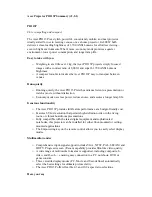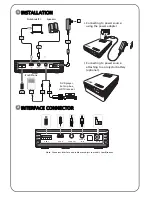
GLOSSARY
DLV 1280 User's Manual
A-3
incident light; screens with gain more than 1 direct more incident light to the
audience but have a narrow viewing angle. For example: An image reflecting off
a 10 gain screen appears 10 times brighter than it would if reflected off a matte
white wall. Curved screens usually have larger gain than flat screens.
A display of help information on the projection screen.
The frequency at which scan lines are generated, which varies amongst sources.
Also called horizontal scan rate or line rate.
The difference between the position of the projector lens and the horizontal
placement of the display. In the DLV 1280 projector, this offset is commonly
measured in pixels.
A circular area of a screen where the image appears brighter than elsewhere on
the screen. The hot spot always appears along the line of sight and "moves" with
the line of sight. High gain screens and rear screens designed for slide or movie
projection usually have a hot spot.
A physical connection route for a source (input) signal.
Signal sent from a source to the projector.
A device that accepts an input signal for display by the projector.
A method used by video tape players and some computers to double the vertical
resolution without increasing the horizontal line rate. If the resulting frame rate
is too low, the image may flicker depending on the image content.
A small push-button device which allows the user to control projector settings
and operation. There are three different DLV 1280 keypads: built-in, IR remote,
and wired remote (optional). For more information, refer to 3.3, Using the
Keypads.
A distortion of the image which occurs when the top and bottom borders of the
image are of different lengths. Side borders slant in or out, producing a keystone
shaped image.
The reproduction of the horizontal and vertical size of characters and/or shapes
over the entire screen.
When light from a projector is incident on a screen, the light reflects from the
screen such that the angle of reflection equals the angle of incidence. The Line
of Best Viewing is along the line of reflection.
The method of feeding a series of high impedance inputs from a single video
source with a coaxial transmission line in such a manner that the line is
terminated with its characteristic impedance at the last input on the line.
Unit of measure for the amount of visible light emitting from a light source.
The amount of visible light per square meter incident on a surface.
1 lux = 1 lumen/square meter = 0.093 foot-candles
Help Screen
'
Horizontal Frequency
'
Horizontal Offset
'
Hot Spot
'
Input
'
Input Signal
'
Interface
'
Interlace
'
Keypad
'
Keystone
'
Linearity
'
Line of Best Viewing
'
Loopthrough
'
(Loopthru)
Lumen
'
Lux
'
















































